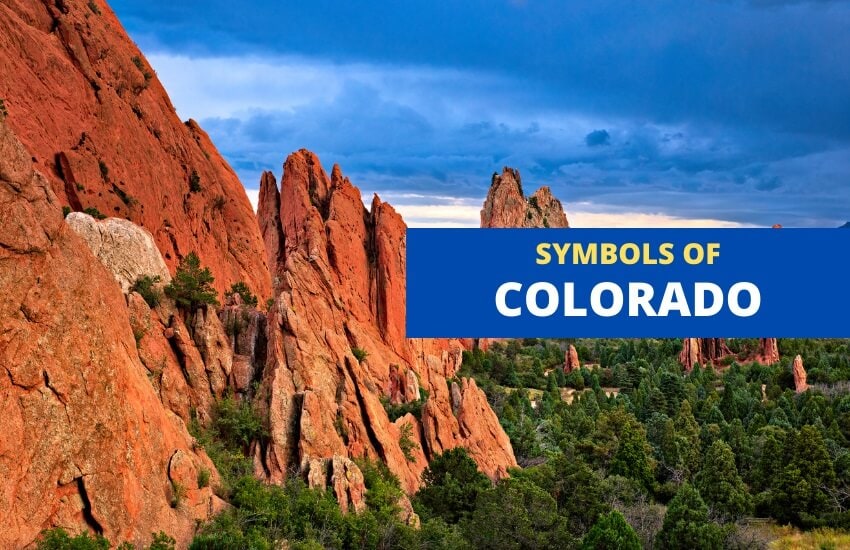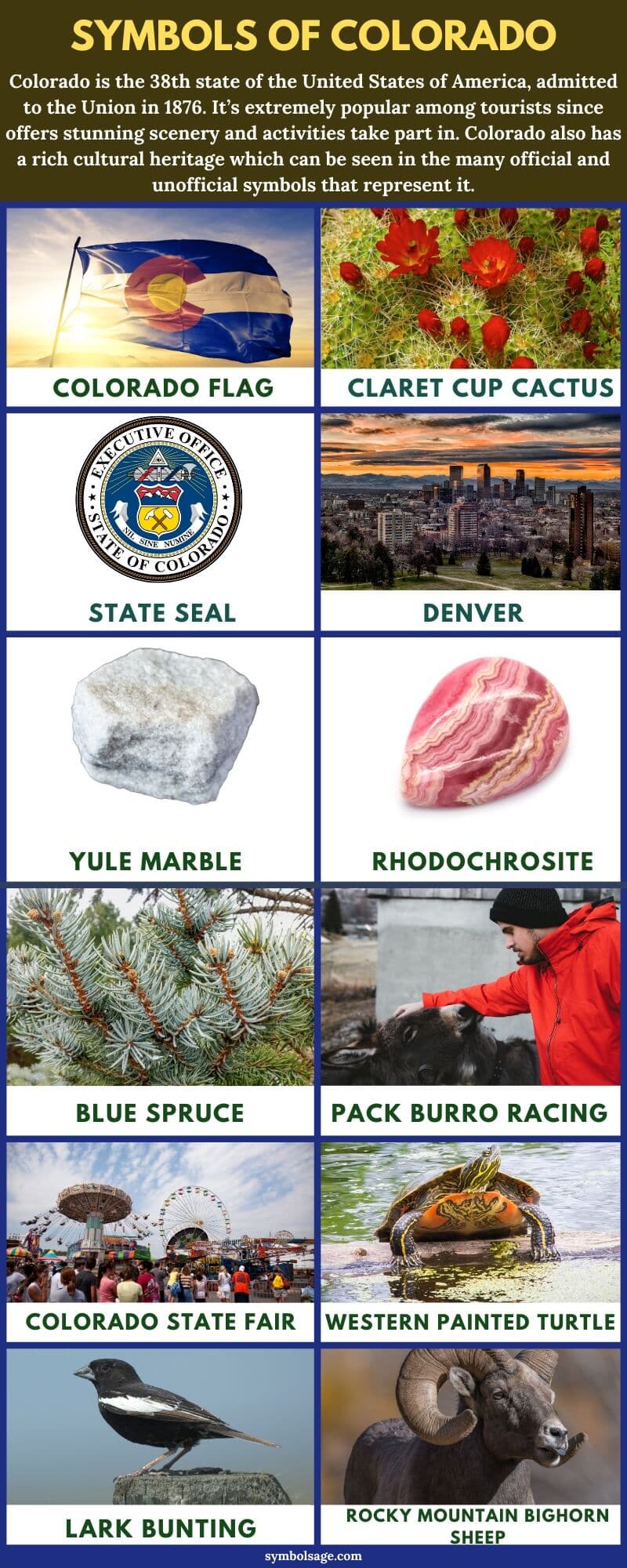
Table of Contents
Colorado is the 38th state of the United States of America, admitted to the Union in 1876. It’s extremely popular among tourists since offers stunning scenery and activities take part in, including hiking, camping, hunting, fishing, mountain biking and white-water rafting. Colorado also has a rich cultural heritage which can be seen in the many official and unofficial symbols that represent it.
The official designation of many state symbols of Colorado was influenced by its school children and their teachers who were involved in the legislative process. Let’s take a quick look at some of these symbols and the story behind them.

Flag of Colorado
The state flag of Colorado is a bicolored flag with two equal-sized horizontal bands of blue on the top and bottom and white band in between. Superimposed on this background is a red letter ‘C’ with a golden disk in the centre. The blue represents skies, the gold represents the abundant sunshine of the state, white symbolizes the snow-capped mountains and red stands for the ruddy earth.
Designed by Andrew Carson in 1911 and officially adopted in the same year by the Colorado General Assembly, the flag is incorporated into the state highway markers. In fact, Colorado is the only one of the U.S. states to incorporate the design of its entire flag into its State Route Markers.
State Seal of Colorado
The Great Seal of Colorado is a circular one depicting the same colors present on the state flag: red, white, blue and gold. Its outer edge features the state name and on the bottom is the year ‘1876’ – the year Colorado became a U.S. state.
The blue circle in the centre contains several symbols depicting authority, leadership and government. Within the circle is the State Motto: ‘Nil Sine Numine’ which means ‘Nothing without the Deity’ in Latin. At the top is an all-seeing eye, representing the power of the deity.
Approved in 1877, the use of the seal is authorized the Colorado Secretary which makes sure that it’s properly used in its correct size and form.
Claret Cup Cactus
The Claret Cup Cactus (Echinocereus triglochidiatus) is a type of cactus native to the southwestern U.S. It’s a resident of various habitats like low deserts, scrubs, rocky slopes and mountain woodlands. It’s most abundantly seen in shady areas.
The cactus is one of the easiest cactus varieties to grow and is extensively cultivated for its exquisite flowers and edible fruit. In 2014 the claret cup cactus was named the official cactus of the state of Colorado thanks to the efforts of four young girls from the Douglas County Girl Scout Troop.
Denver
In 1858, during the time of the Pike’s Peak Gold Rush, a group of prospectors from Kansas established a mining town on the South Platte River banks. This was the first historical settlement, later known as the city of Denver. Today, Denver is the capital city of Colorado and with a population of about 727,211 people, it’s the most populous city in the state. It’s also known as the ‘The Mile-High City’ since its official elevation is exactly a mile above sea level.
Yule Marble
Yule Marble is a type of marble made of metamorphosed limestone that’s found only in Yule Creek Valley, Colorado. This rock was first discovered back in 1873 and unlike most other types of marble which are quarried from open pits at low elevations, it’s quarried underground at 9,300 feet above sea level.
The marble is made of 99.5% pure calcite and has a grain structure that gives it its smooth texture and luminous surface. Although it’s more expensive than other marbles, these qualities were the reason it was chosen to clad the Lincoln Memorial and several other buildings throughout the U.S. In 2004, it was designated the official rock of the state of Colorado.
Rhodochrosite
Rhodochrosite, a manganese carbonate mineral, is a rose-red mineral, extremely rare in its pure form. Impure specimens are usually found in pink to pale brown shades. It’s mainly used as manganese ore, a key component o certain aluminium alloys and many stainless-steel formulations.
Colorado officially designated rhodochrosite as its state mineral in 2002. The largest rhodochrosite crystal (called the Alma King) was discovered in the Sweet Home Mine near a town called Alma in Park County, Colorado.
Colorado Blue Spruce
The Colorado blue spruce, also called the white spruce or green spruce, is a type of spruce tree native to North America. It’s a coniferous tree with blue-green needles and scaly grey bark on its trunk. Its branches are yellowish-brown and the leaves are waxy, with a grayish-green color.
The spruce is extremely important to the Keres and Navajo Native Americans who used it as a ceremonial item and traditional medicinal plant. The twigs were given to people as gifts because they were said to bring good luck. Due to the value of the spruce, Colorado named it the official state tree in 1939.
Pack Burro Racing
Indigenous to Colorado, pack burro racing is an interesting sport deeply rooted in the mining heritage of the state. In the past, miners took burros (the Spanish word for donkeys) through the Colorado mountains while they were prospecting. The miners couldn’t ride the burros who were carrying the supplies, so they had to walk, leading the burros along.
Today, the Burros Races are held throughout little towns in Colorado to commemorate these men, women and their burros, with a runner leading the donkey with a rope. The main rule of the sport – the human can’t ride the burro, but the human can carry the burro. This sport was recognized as the official heritage sport of the state of Colorado in 2012.
Colorado State Fair
The Colorado State Fair is a traditional event held every year in August in Pueblo, Colorado. The fair has been a traditional event since 1872 and is a division of the Colorado Department of Agriculture. By the time Colorado became a U.S. state in 1876, the fair had already earned its place in history. In 1969, a large number of people, approximately 2000, converged on what we now know as the city of Pueblo for horse exhibition and the meagre beginning was the birth of the Colorado State Fair. The fair is still held annually, with thousands of people attending and continues to increase in popularity each year.
Molly Brown House Museum
Located in Denver, Colorado, the Molly Brown House Museum was once the home of the American philanthropist, socialite and activist Margaret Brown. Brown was famously known as ‘The Unsinkable Molly Brown’ since she was one of the survivors of the RMS Titanic. The museum is now open to the public and contains exhibits that interpret her life. In 1972, it was listed in the National Register of Historic Places.
Rocky Mountain High
Written by John Denver and Mike Taylor, Rocky Mountain High is one of the two official songs of the U.S. state of Colorado. Recorded in 1972, the song was in 9th place on the US Hot 100 a year later. According to Denver, the song took him an extremely long nine months to write and was inspired by his move to Aspen, Colorado, expressing his love for the state.
Western Painted Turtle
The western painted turtle (Chrysemys picta) is native to North America and lives in slow-moving fresh waters. According to fossils that were discovered, the turtle is said to have existed nearly 15 million years ago. In 2008, it was adopted as the official state reptile of Colorado.
The painted turtle has a smooth dark shell, without a ridge like most other turtles have. It has olive to black skin with red, yellow or orange stripes on its extremities. The turtle has been a victim of road killings and habitat loss which has caused a reduction in its population but because it has the ability to live in places disturbed by humans, it remains the most abundant turtle in North America.
Lark Bunting
The lark bunting bird (Calamospiza melanocorys) is an American sparrow native to western and central North America. It was designated the state bird of Colorado in 1931. Lark buntings are little songbirds with short, bluish, thick bills and a large white patch on their wings. They have short tails with white-tipped feathers and the males have an entirely black body with a big white patch on the upper part of their wings. They forage on the ground, eating insects and seeds and they usually feed in flocks outside of the nesting season.
Rocky Mountain Bighorn Sheep
The Rocky Mountain Bighorn Sheep is a magnificent animal that was adopted as the official animal of Colorado back in 1961. Native to North America, the sheep is named for its large horns which can weigh up to 14 kg. They’re highly social animals that are often found in the cool mountainous regions of the United States and Canada.
The bighorn sheep is susceptible to certain types of diseases carried by most domestic sheep such as pneumonia and psoroptic scabies (mite infestation). They live in large herds and don’t typically follow a leader ram. Today, the bighorn sheep is an important symbol of creativity, peace, purity, courage and sure-footedness as well as the circle of life.
Check out our related articles on other popular state symbols:
Symbols of California








